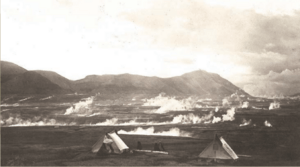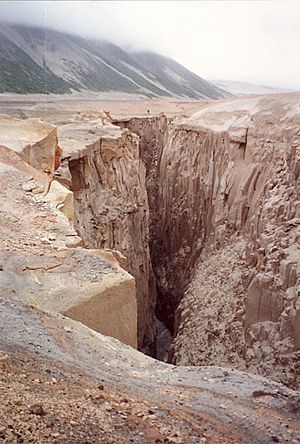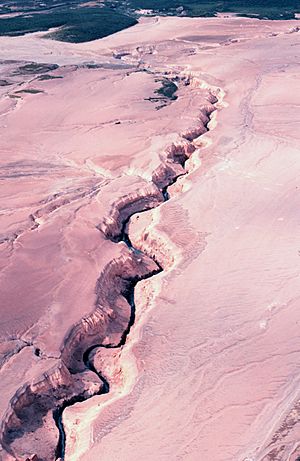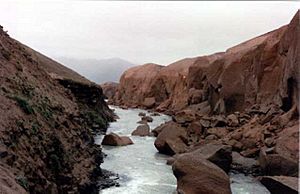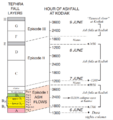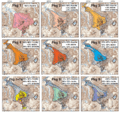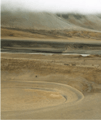Valley of Ten Thousand Smokes facts for kids
The Valley of Ten Thousand Smokes is a special valley located within Katmai National Park and Preserve in Alaska. It's filled with a thick layer of volcanic ash that came from a huge eruption of the Novarupta volcano. This massive event happened between June 6 and 8, 1912.
After the eruption, thousands of fumaroles, which are like natural steam vents, released steam from the ash. Robert Fiske Griggs, an explorer from the National Geographic Society, visited the valley in 1916. He was so amazed by the sight that he named it the "Valley of Ten Thousand Smokes." He said that the whole valley was full of "hundreds, no thousands—literally, tens of thousands—of smokes curling up from its fissured floor."
Before the 1912 eruption, this area was just a normal part of the Ukak River valley. It wasn't a famous place and didn't even have a name. Even though people didn't live there permanently, it was a path used by the Alutiiq people and animals like grizzly bears.
Contents
What is the Valley of Ten Thousand Smokes?
The ash-filled valley covers about 40 square miles (100 km²). The ash can be incredibly deep, up to 700 feet (210 m) in some places. Over time, rivers like the River Lethe have cut deep canyons into the ash. This allows visitors to see the different layers of ash that were laid down during the eruption.
Today, most of the fumaroles have stopped steaming because the ash has cooled down. So, despite its name, the valley is no longer filled with 'smoke' (which was actually steam). Plants still find it very hard to grow in the valley, but you can still see signs of volcanic activity on the nearby hills.
The Big Eruption of 1912
The 1912 eruption of Novarupta was the largest eruption by volume in the entire 20th century. It released about 13 cubic kilometers (3.1 cubic miles) of magma. This is a huge amount!
During and after the eruption, there were many earthquakes. As many as 14 major earthquakes, between magnitude 6 and 7, shook the area. More than 100 earthquakes stronger than magnitude 5 also occurred. These quakes happened because the ground collapsed to form a caldera at Mount Katmai and magma moved underground.
The explosion from the eruption was so loud that people heard it as far away as Fairbanks and Juneau, which are hundreds of miles away. The volcanic dust traveled very far. It reached Wisconsin in the United States by June 8 and even Algeria in Africa by June 19!
In 1916, Robert Griggs saw thousands of fumarole plumes, some over 500 feet (150 meters) high. By 1917, steam was still coming out, and the ground was very hot, about 97 °C (207 °F) just 1 meter (3 feet) below the surface. Over time, the valley cooled down. By 1929, only a few hundred steam vents were left, and by 1940, there were only about 10.
Visiting the Valley Today
Most visitors to the Valley of Ten Thousand Smokes arrive by bus. There's a 20-mile (32 km) road from Brooks Camp, which is the only road in Katmai Park. The valley is a popular spot for photographers and people who love nature.
The Alaska Volcano Observatory still watches the activity of Katmai and other nearby volcanoes. There are 5 active volcanoes within 15 kilometers (9.3 miles) of Katmai, all part of what's called the Katmai Cluster.
Astronauts Trained Here!
Did you know that the Katmai area, especially this valley, was used by NASA to train astronauts? The USGS and NASA helped the Apollo astronauts learn about volcanic features. They studied landforms and materials, especially fumaroles and vents, to prepare for their missions to the Moon.
Two groups of astronauts trained here, one in 1965 and another in 1966. Their training included pretending they were on a lunar mission. They would be dropped off in a spot with little information, then plan their routes and collect rock samples. They even talked to their geologist teachers over the radio, just like they would on the Moon!
Some famous astronauts who used this training on the Moon include Apollo 11's Buzz Aldrin, Apollo 12's Alan Bean, Apollo 14's Edgar Mitchell, Apollo 15's James Irwin, Apollo 16's Charlie Duke, and Apollo 17's Gene Cernan and Jack Schmitt.
Images for kids


